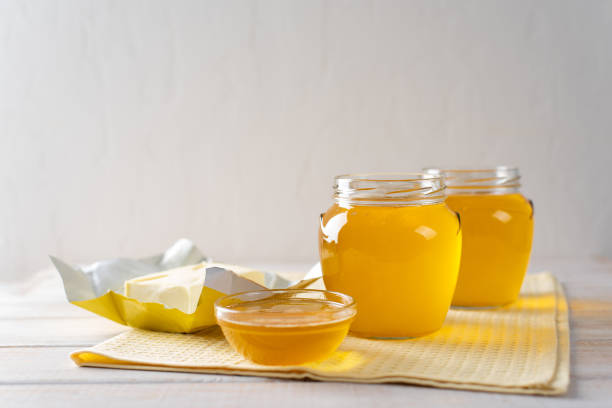Ghee is the elixir in Ayurveda. It is the antidote for most of the medicine-based complications and even in case of poisoning.
This blog is a part of the explanatory series of the following shloka from Charak Samhita.
षष्टिकाञ्छालिमुद्गांश्च सैंन्धवामलके यवान् ।
आन्तरीक्षं पयः सर्पिर्जांगलं मधु चाभ्यसेत्।।
Charak Samhita Sutra Sthana (5th Chapter – 12)
There are many synonyms of Ghee. One of them is “sarpi”. The Sanskrit word “sarpi” has a literal meaning – the one that slithers or flows. This particular word “sarpi” has a deep significance. Like ghee, the word sarpi also has multiple meanings.
- something that increases or moves (displacement)
Because of this meaning, Ghee (Clarified Butter Milk) is also called sarpi, as it helps the body to grow. At the same time, this word refers exclusively to the liquid flowy ghee and not thickened butter or saturated fats like vegetable oils – a liquid that flows and is capable of displacement.
If we consider ghee as a reference for the word sarpi, then the word sarpi refers specifically to the melted flowy butter and not the solid/cold/hardened butter. And this point is crucial to choose the right sarpi!

The Flowy Nutrition
This word means that you should consume ghee that is melted or in a flowy form.
Now, there are two ways to consume flowy ghee –
- either the temperature should be high so that the butter remains liquid,
- or you should always heat the butter before using it.
But there is another crucial factor – the quality of ghee. This statement indicates you should consume a ghee that always remains flowy no matter what the climate or the temperature is. And this is the crucial factor!
Read our popular article – Does Ayurveda Recommends Milk Intake Everyday?
Ayurveda defines eight primary types of milk –
- Cow
- Buffalo
- Goat
- Sheep
- Camel
- Elephant
- Horse
- Donkey
Charak Samhita also describes the qualities of human milk!
And you can make ghee out of all these. So, you can have eight types of ghee. But there is one type of ghee that is the most recommended – cows ghee.
If we compare the physical properties of all types of ghee, cows ghee is the one that is called elixir in Ayurveda. Why?
Buffalo vs Cow Ghee
Let us take the example of buffalo ghee. The normal buffalo ghee is white and it solidifies in cold temperature. But, cows ghee is different, it is yellowish. The upper layer of cows ghee stays liquid under almost all climatic conditions. So, we can conclude that Acharya Charak is referring to cows ghee exclusively when he uses the word sarpi and not to any other type of ghee.

Which is the real Sarpi? – A2 or A1 Ghee
There is yet another very important factor – the breed of the cow. Unfortunately, most of the “cows” that we have today are a hybrid between the cows and the buffaloes. For better milk productions, scientists developed hybrid cows. And it helped to significantly increase the amount of milk production.
But there is one significant difference between the milk of natural breeds and the hybrids. All kinds of milk contain a protein called beta-casein protein. The milk from these hybrid cows contains a special type of protein called A1 beta-casein protein, whereas milk from the natural breed contains A2 beta-casein protein.
The Allergy Causing Milk
Some scientific studies have shown evidence that abnormal A1 milk is the real cause for dairy allergy, digestive disorders, etc. It is also linked to autoimmune and inflammatory disorders. As the abnormal A1 beta-casein protein enters the body, the body is not able to recognize this protein and flags it as a potentially dangerous foreign substance. This flagging may result in severe or mild autoimmune reactions or allergies.
Milk allergy was completely unheard of in India a few decades back. Cow’s milk was the first thing recommended for all kinds of inflammatory disorders.

However, with the advent of imported jersey cows, incidences of milk allergy have shot up significantly in the past decade.
And this A1 milk is white and it solidifies sometimes even at the normal temperature!!! On the other hand, A2 milk from the natural indigenous cows is light yellowish and the upper layer of the A2 ghee never solidifies. I have recommended A2 ghee to people living in frigid climatic conditions and they reported that the upper layer of A2 ghee remains liquid even in extremely cold climates.
Therefore, this single word sarpi makes a huge difference in the interpretation. And it gives the correct answer for all situations. Probably, that’s why Ayurveda is called eternal wisdom!
The bottom line is – a substance that is flowy (sarpi) should be consumed daily. Applying general logic, the most nutritious and edible “sarpi” is ghee from native natural cow breeds only!!!
It is not buffalo ghee or ghee made from the milk of any other animal. Also, this statement from Charak Samhita gives us a clarification about the preference for A2 ghee over A1 ghee.

The Vegan Sarpi/Ghee
In this manner, there can be several substances that can fit this definition of sarpi. Therefore, the word “sarpi” also opens up the conversation for a vegan option for cow-based ghee. Cow’s ghee is definitely the best fit for sarpi, however, there can be there are other options as well.
In this manner, multiple other fluids like coconut oil, almond butter, cashew butter, etc. may also come under sarpi. But they are not as flowy as A2 cows ghee.
Due to this meaning of the word sarpi, it is also synonymous with water. Water is also a nourishing fluid that helps the body to grow and sustain.
One may wonder why should Acharya Charak prescribe to drink water every day. It is understood that we cannot live without water. But, as most of us ignore thirst due to stress or hyperactivity, it is important to prescribe water as an important addition to our daily diet.
Besides, Ayurveda believes that water also contains nutrients. Water from one place is different from the other. And therefore, the digestive system also digests the water we drink and makes it homogeneous to the tissue fluids.
There can be various deeper meanings to each word written in the ancient texts, thanks to the Sanskrit language. I hope that this information brings you the best of health and happiness! In the next blog, let us discover the importance of non-vegetarian food in Ayurveda.
